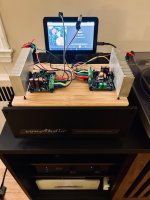Proof of concept: I’m powering Mod86 10th Anniversary boards with my big separate dual +/-24VDC CLC power supply usually slated for class A amp duty. It sounds just lovely, with a totally silent background. 
With a proper chassis, this will be my summer amp.

With a proper chassis, this will be my summer amp.
Attachments
I am glad you like it!Proof of concept: I’m powering Mod86 10th Anniversary boards with my big separate dual +/-24VDC CLC power supply usually slated for class A amp duty. It sounds just lovely, with a totally silent background.
With a proper chassis, this will be my summer amp.
Nice 'n easy!Proof of concept: I’m powering Mod86 10th Anniversary boards with my big separate dual +/-24VDC CLC power supply usually slated for class A amp duty. It sounds just lovely, with a totally silent background.
With a proper chassis, this will be my summer amp.
Which inductor are you using on power supply?
Or buy online (which does seem to have become a somewhat popular approach for both vendors and consumers )That is precisely why I think people should lean DIY if able to, especially if it's a great product in a convenient kit form with testing/debugging help. Way more bang for the buck, with the ability and knowledge to fix things in the future.
So if I put a Modulus 86 on a heat sink within a Slimline enclosure, so not in free air, how long of a 2U heat sink would I need? This is not in free air so not sure sure how much to derate it. Using a 2x22VA transformer.
You'll be fine with any reasonable load. I am using mine with rails at +-25.1 or so VDC at idle.
Skip
Skip
I have 105 mm length planned for each module. They will be for my surrounds. Center channel will get 200mm heat sink. Building 3 channels into the enclosure with fully vented top and bottom covers.
Long enough. 😉how long of a 2U heat sink would I need?
It depends on many factors. How thick is the base? How many fins does the heat sink have? Are the fins serrated?
You can always punch your numbers in here: https://heatscapecal.com/natural Use the calculator to get you an estimate of the thermal resistance and device temperature.
If the heat sink is a ModuShop 2U x 200 mm, for example, you can probably squeeze two channels of Modulus-86 onto it. With an internal heat sink you can let the chip run a bit hotter as you don't need to worry as much about burning your fingers on the heat sink. If you design for a heat sink temperature around 70-80 ºC the chip will be fine. The amp will maybe get lukewarm during normal operation but will reach that 70-80 ºC with music at clipping levels for hours and a 4 Ω load.
Tom
- Home
- Amplifiers
- Chip Amps
- Modulus-86 build thread
